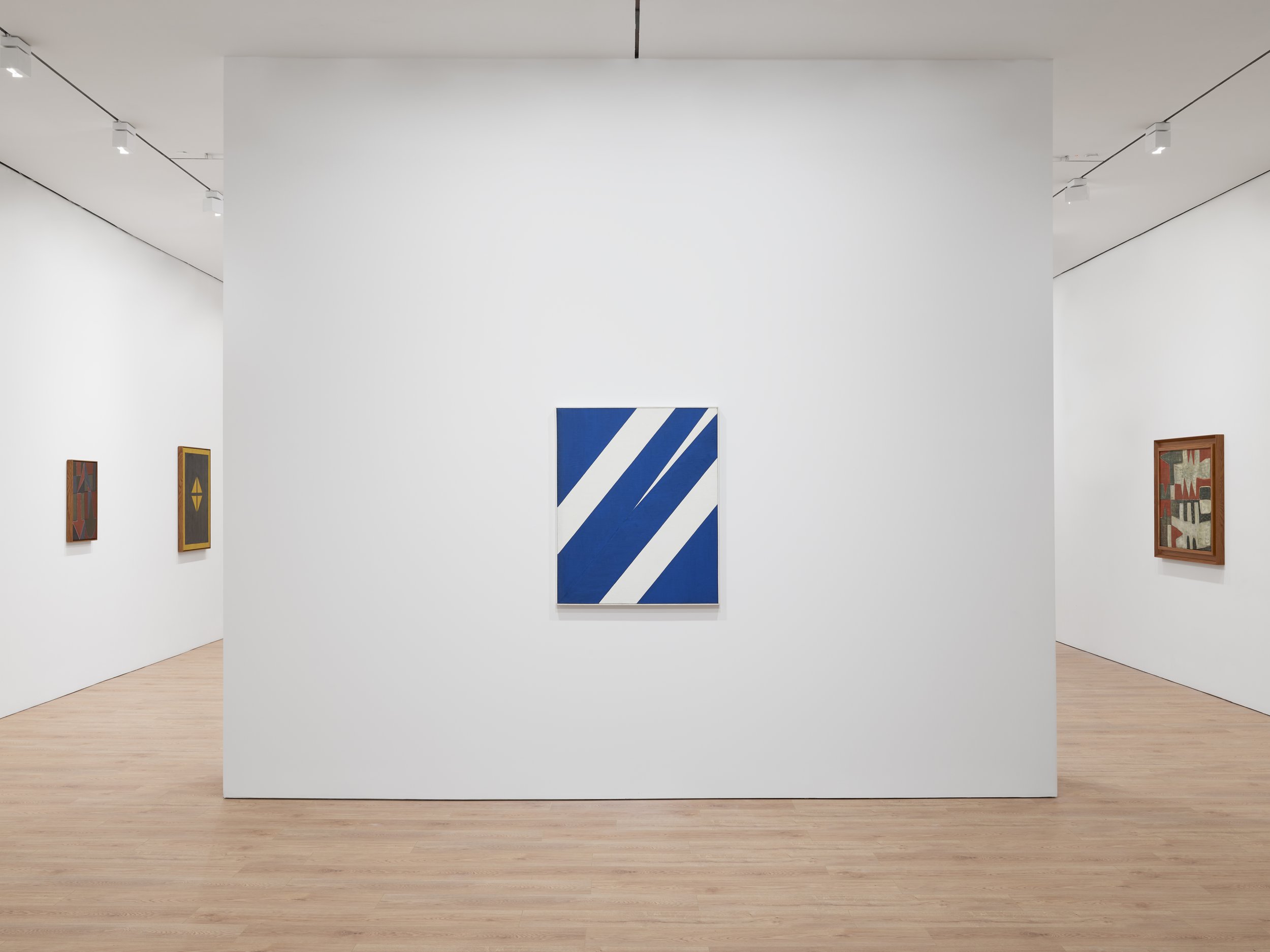Carmen Herrera: The Paris Years 1948 –1953
Exhibition view of ‘Carmen Herrera: The Paris Years, 1948 – 1953’ at Lisson Gallery, New York, 1 May – 1 August 2025 © Carmen Herrera, Courtesy Lisson Gallery
From 1948 to 1953, Carmen Herrera lived in Paris, immersing herself in the city’s dynamic postwar artistic community while frequently traveling to New York and Havana. This period marked a decisive shift in her practice, as she moved from biomorphic forms and fevered, gestural compositions to the rigorous geometric abstraction that would define her career for the next seven decades. A new exhibition at Lisson New York, Carmen Herrera: The Paris Years, 1948 - 1953—the most comprehensive presentation of her work from this period to-date— examines a young artist deep in experimentation, subsuming the seismic influences of many colliding midcentury art movements, in order to develop her own breakthrough language of painting.
Carmen Herrera Conquete de l'air, 1950 Acrylic on canvas 75.9 x 117.2 x 2.2 cm 29 7/8 x 46 1/8 x 7/8 in © Carmen Herrera, Courtesy Lisson Gallery
Herrera’s years in Paris were a time of creative freedom and intellectual exchange, particularly through her participation in exhibitions such as the Salon des Réalités Nouvelles, where she exhibited alongside other prominent figures such as Theo van Doesburg, Max Bill, and Piet Mondrian, as well as younger artists associated with Venezuela’s Los Disidentes, Brazil’s Concretists, and Argentina’s Grupo Madi. The city exposed her to key modernist movements such as Bauhaus and Russian Suprematism, which deeply influenced the shift toward her own uniquely minimal language. During her time in Paris, Herrera began employing shaped canvases while also becoming a pioneer in solvent-based acrylics, a material still novel in postwar Europe. Notably, an important work from this period, Iberic (1949), is currently the oldest work in the permanent collection of the Metropolitan Museum of Art to use this particular medium, a fact that was discovered through scientific analysis by the museum in 2021.
Key works on view include Way (1950), an early example of the hard-edged, dichromatic abstraction that would later become her signature. The painting’s four symmetrical ochre-colored triangles against a black background prefigure later masterpieces such as Black and White (1952) in the permanent collection of the Museum of Modern Art. Another major work from this period, Thrust (1950), exemplifies Herrera’s precision and spatial tension, featuring a striking white dart slashing across a cobalt blue ground. The work, both in its palette and bold linear composition, foreshadows Herrera’s future direction while also underscoring her approach to painting as object. This idea is further emphasized by the use of an artist-made frame, which was intended to prevent a buyer from re-framing the work. This concept evolves in subsequent pieces where she allowed her compositions to wrap about the edges, transforming them into fully three-dimensional forms.
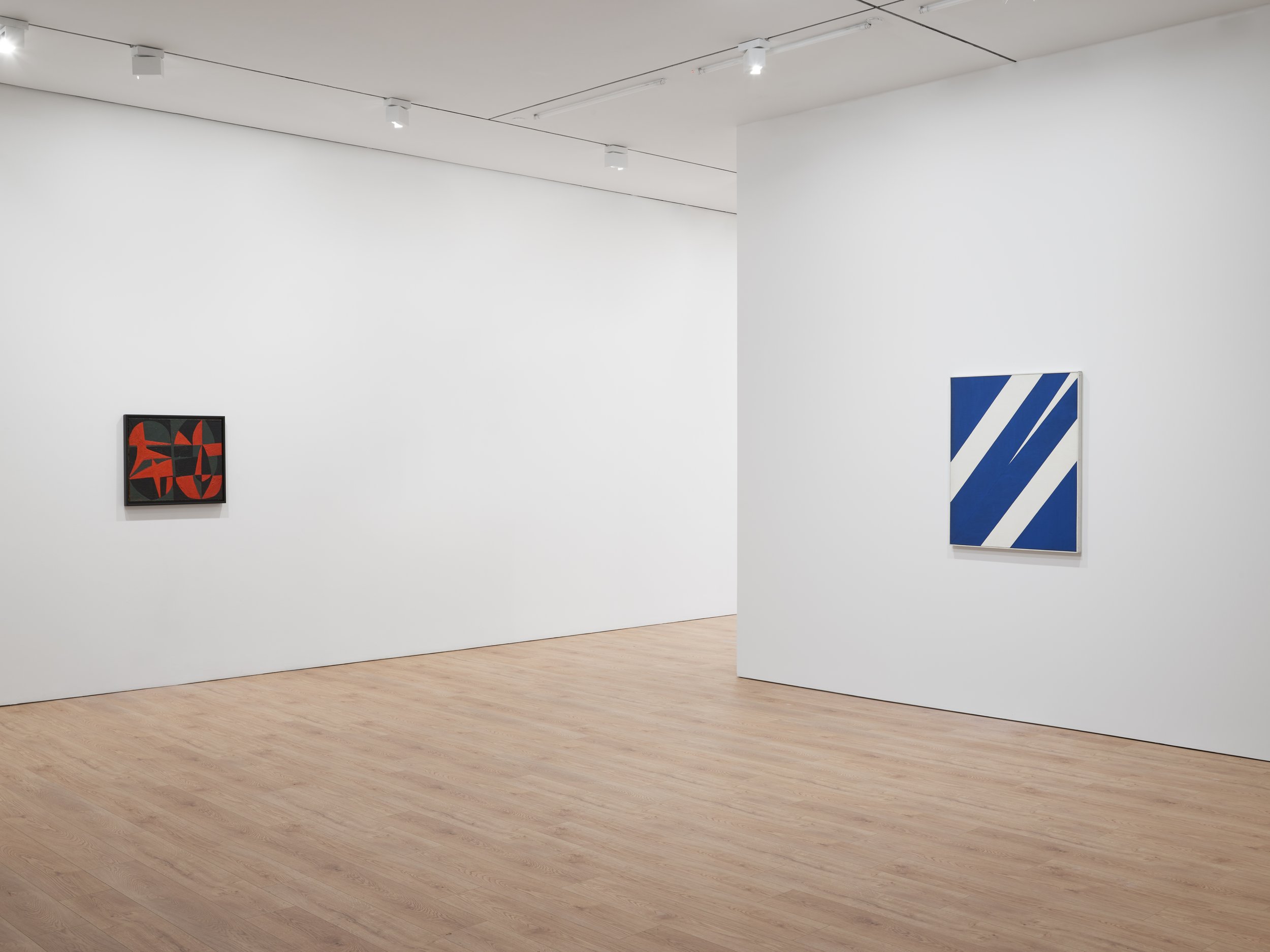
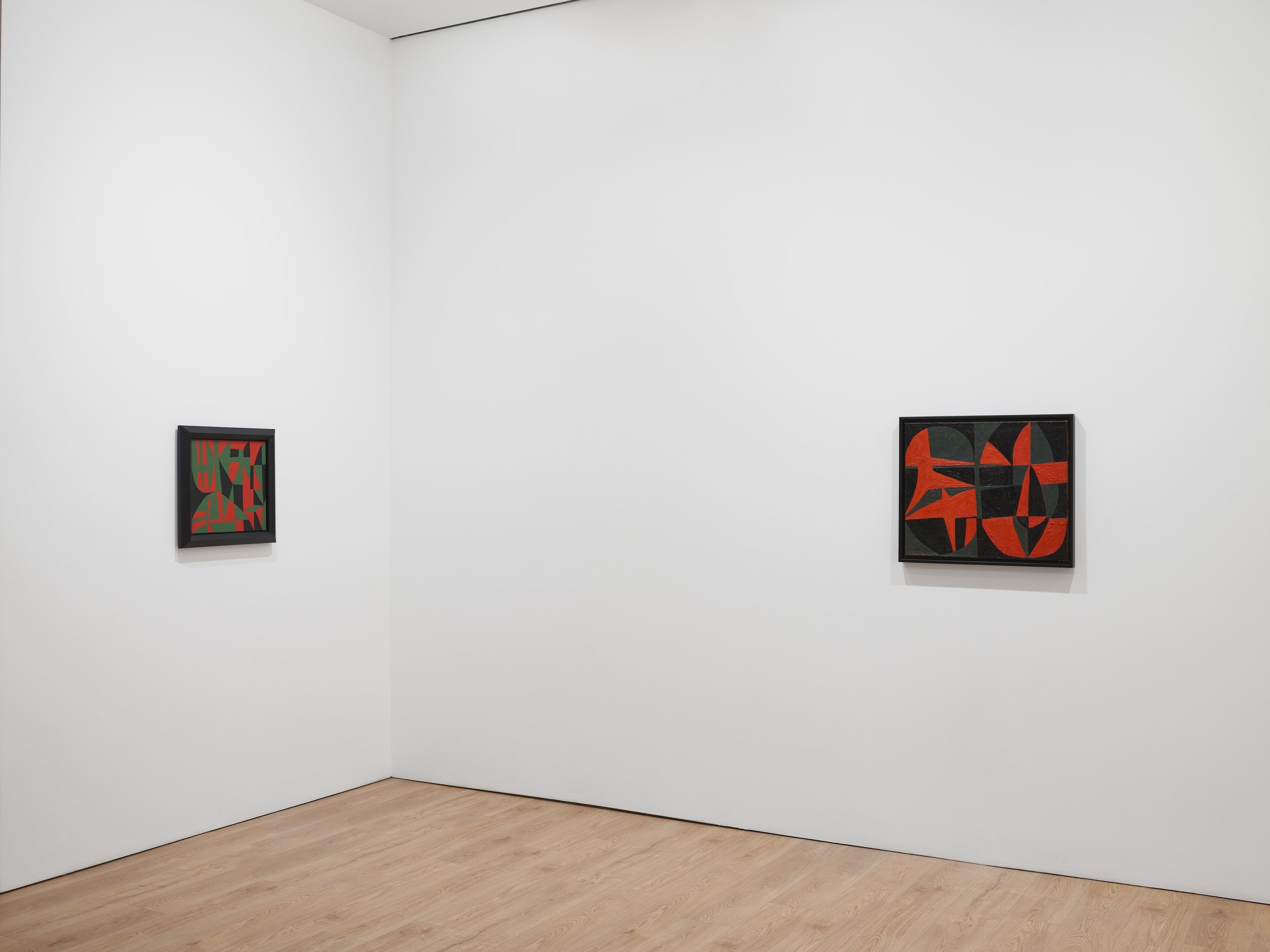
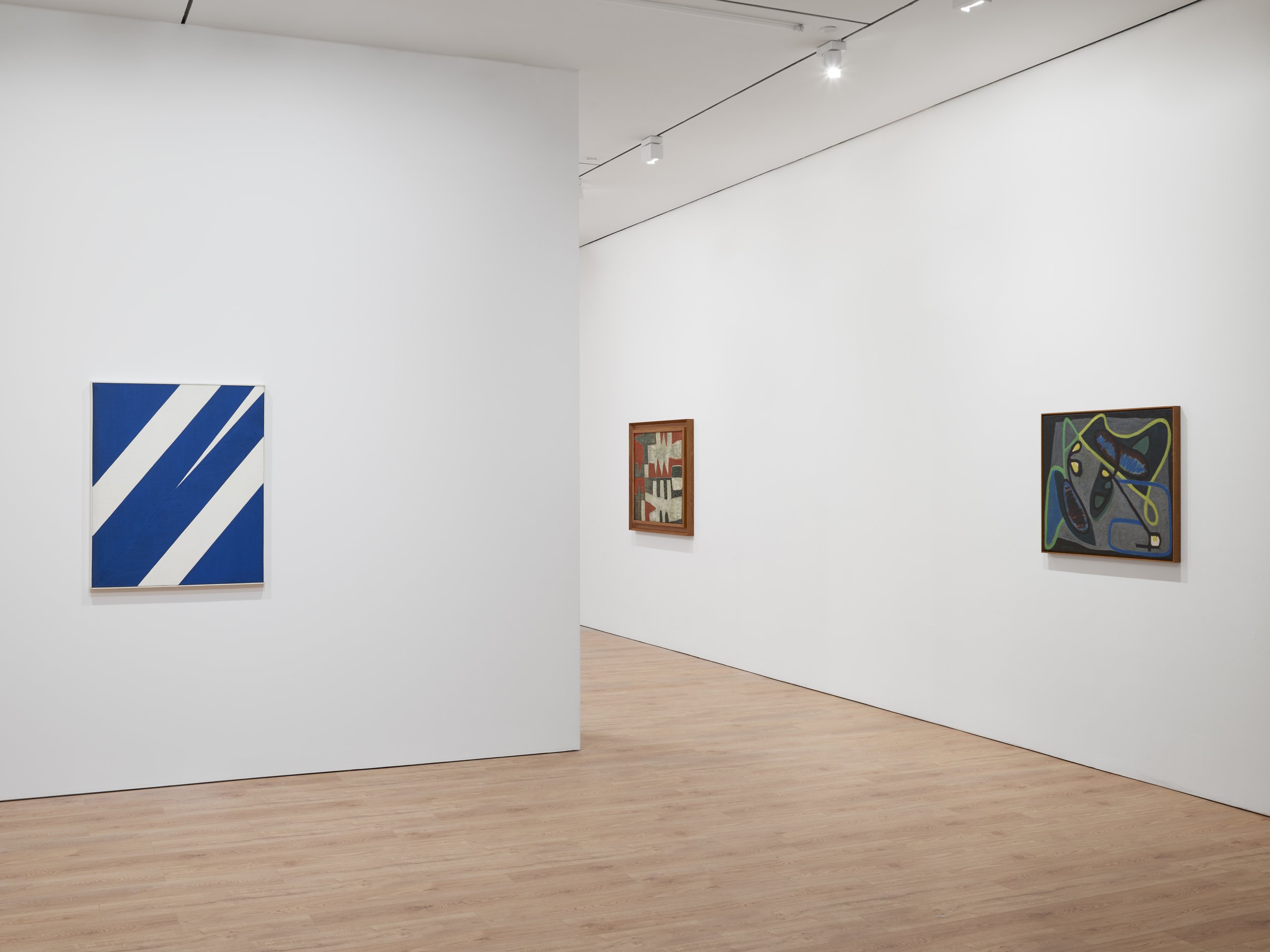
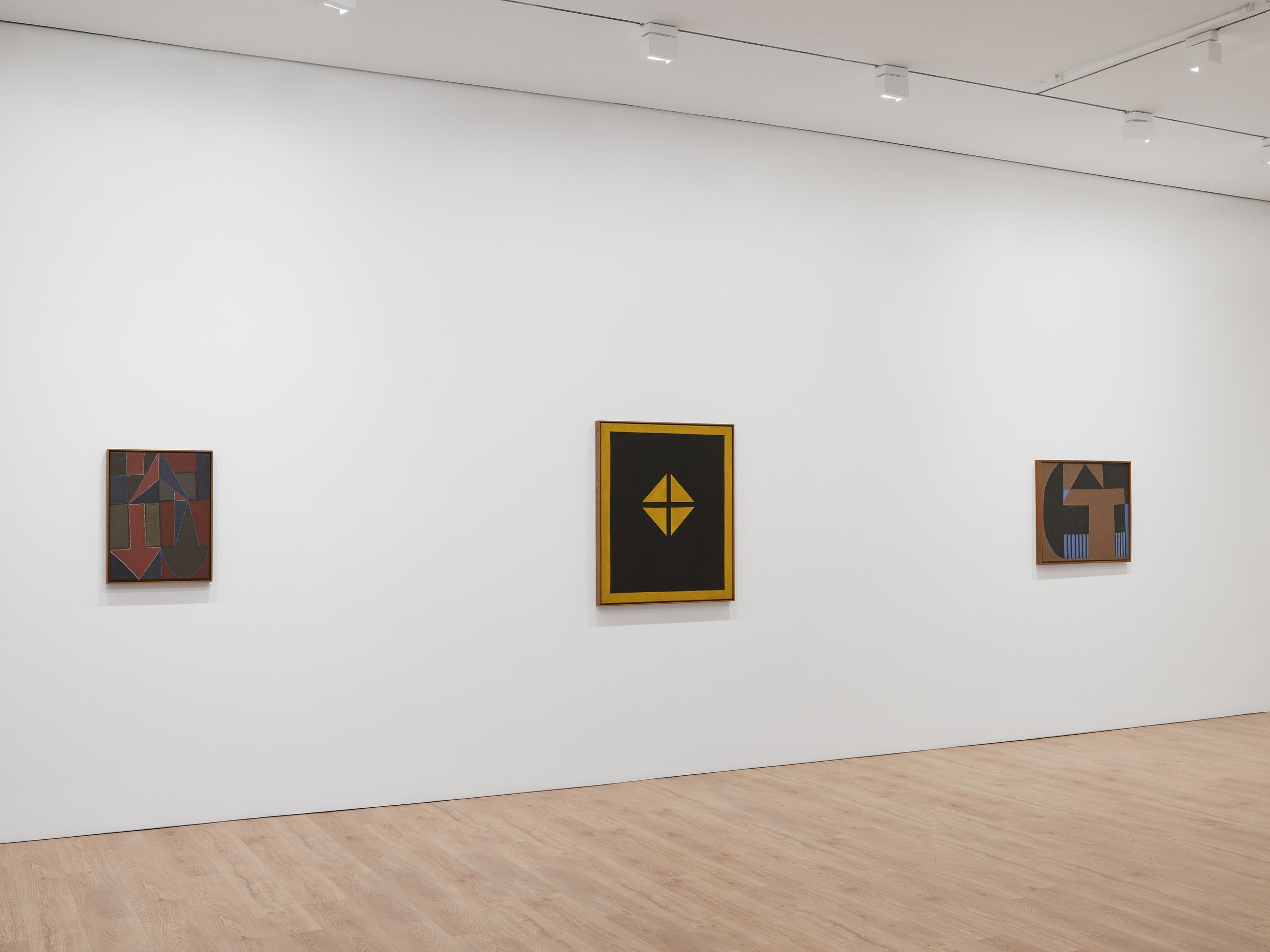

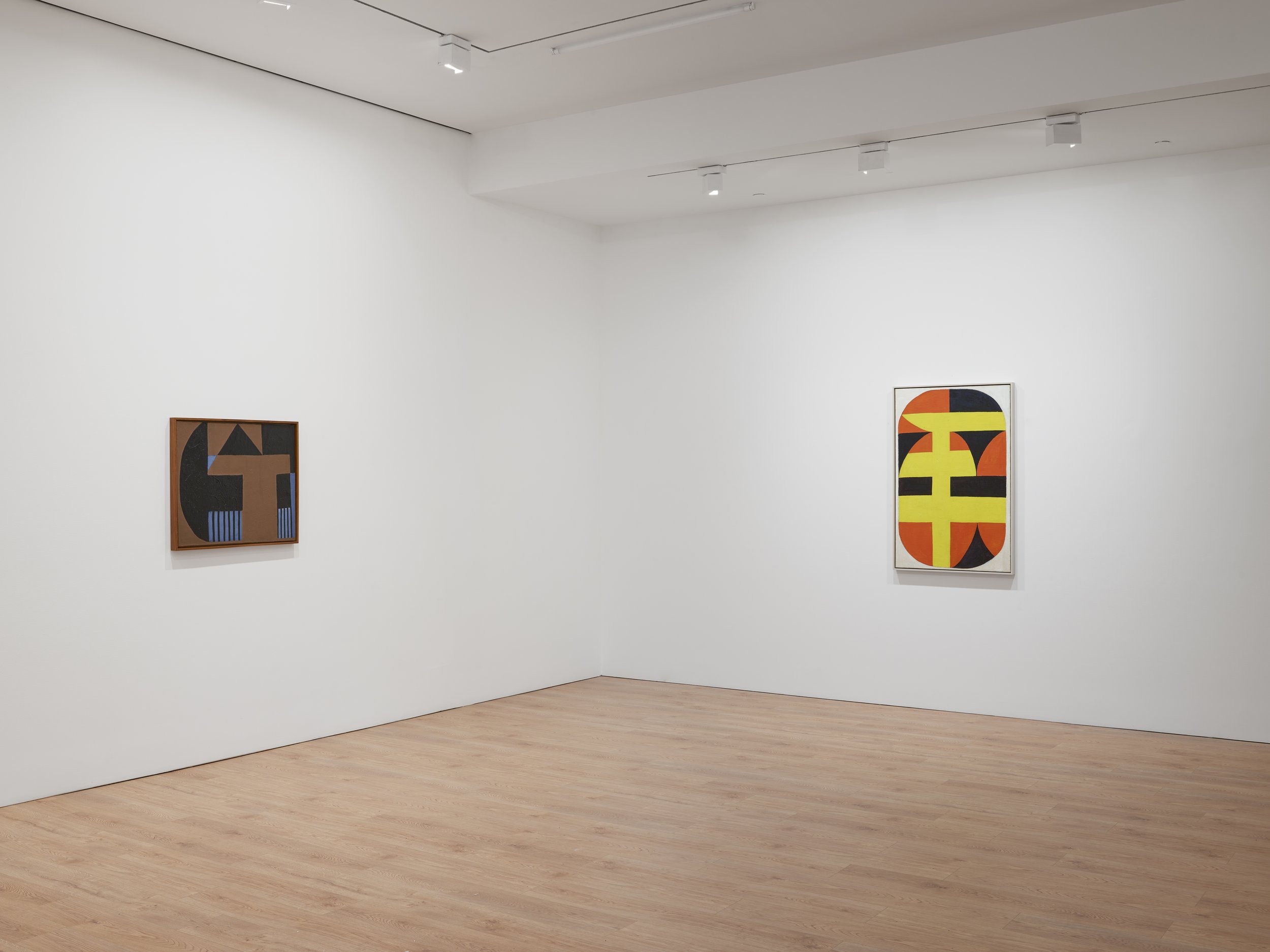


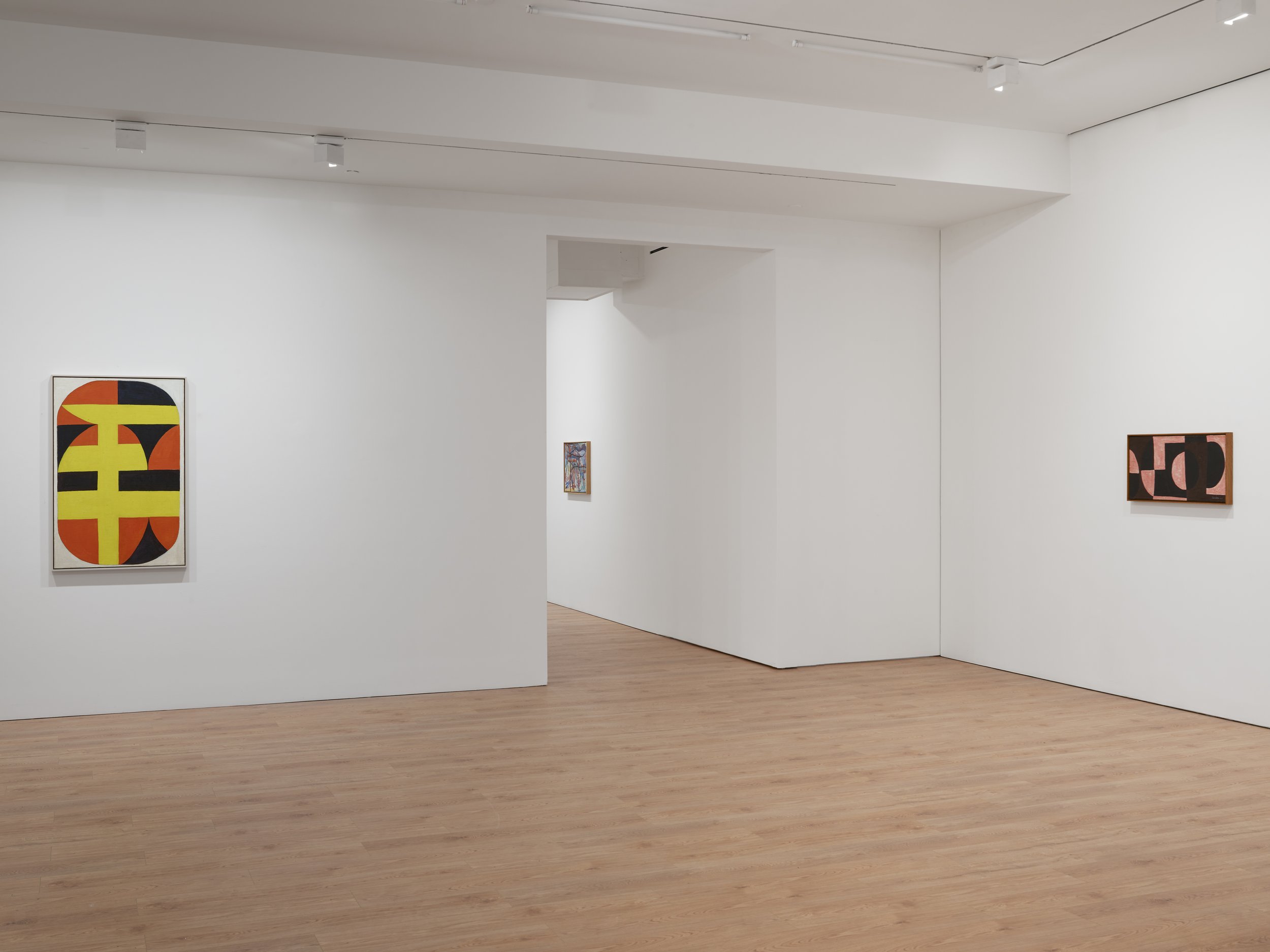
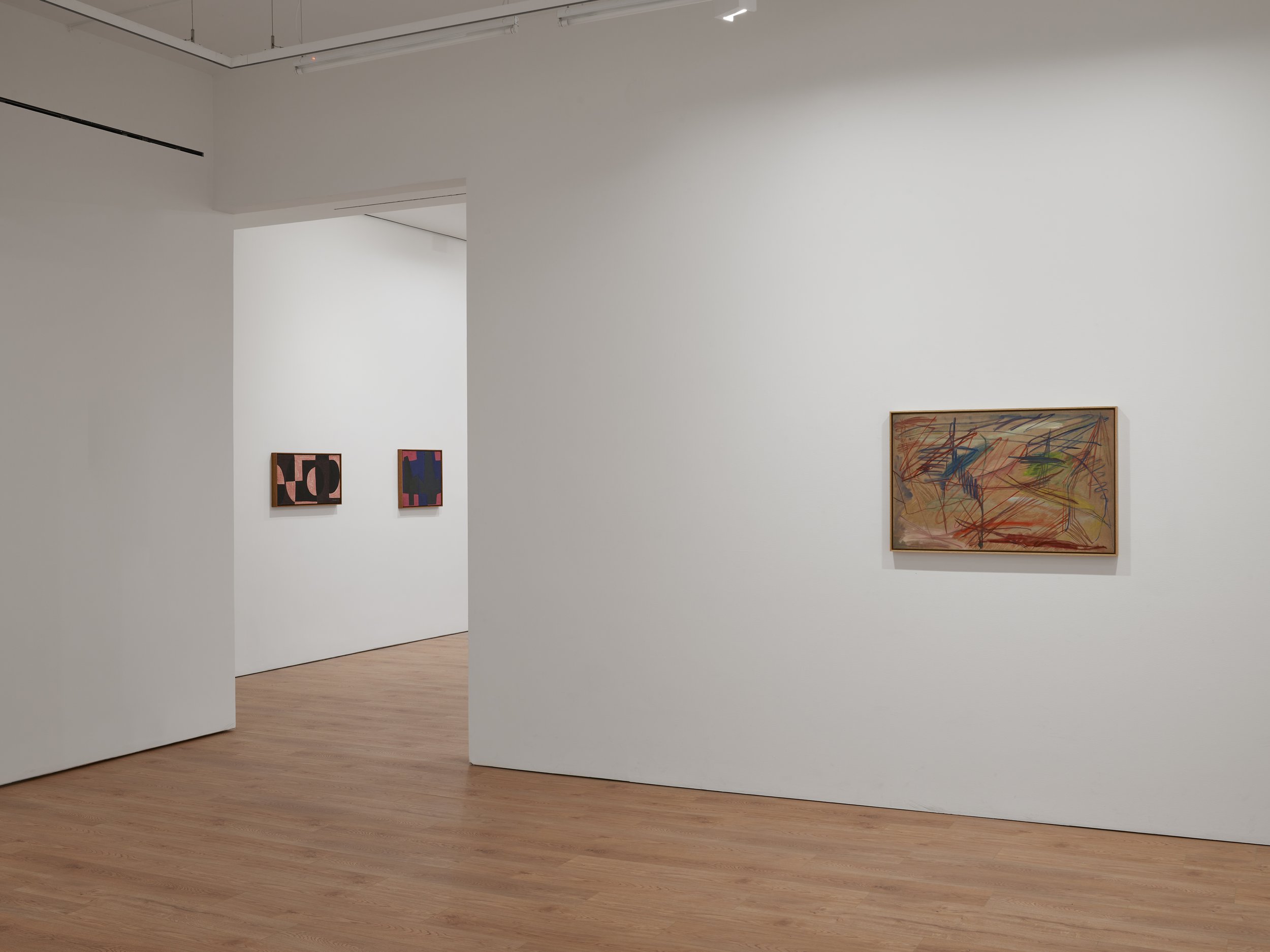
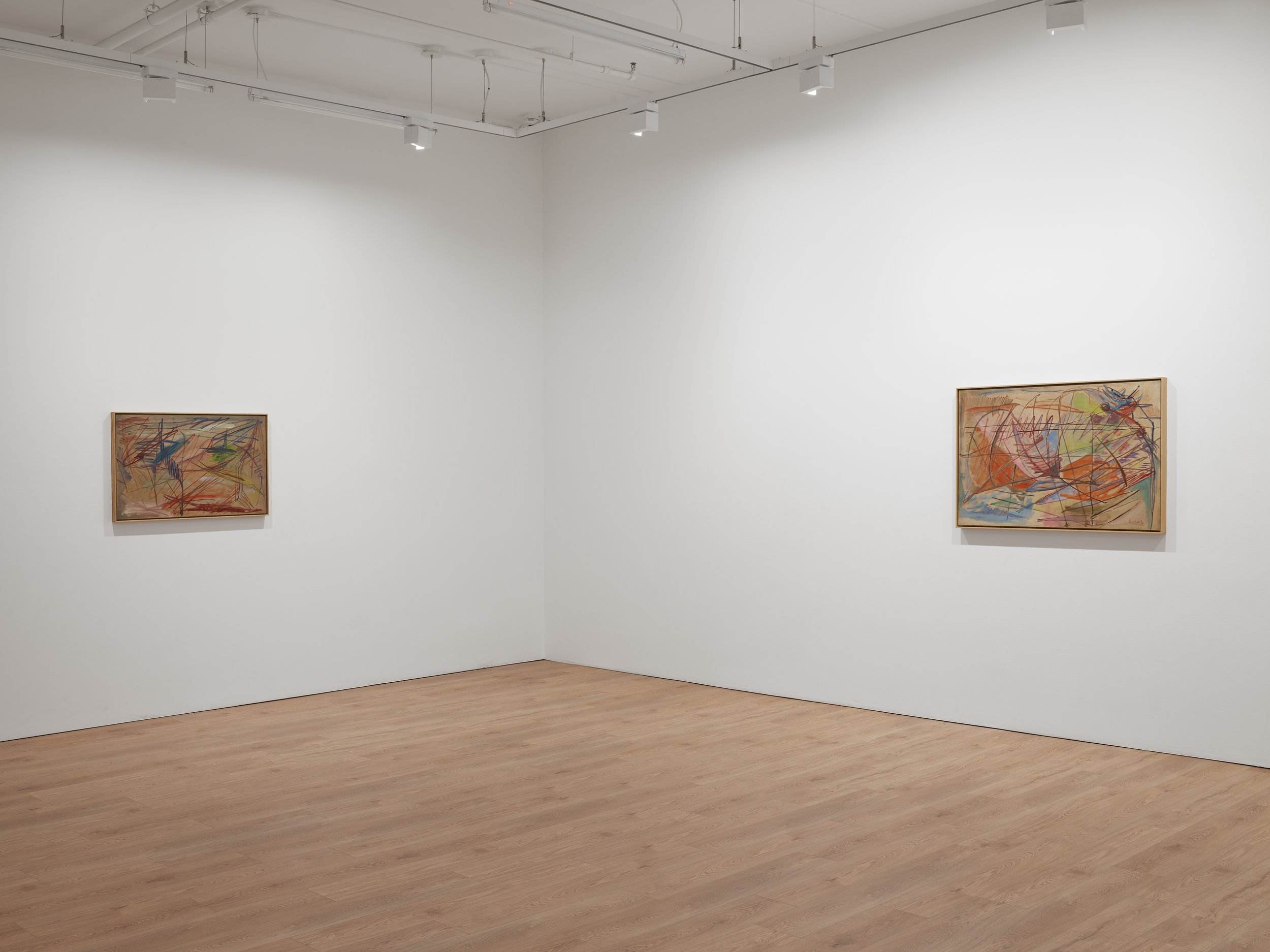
Exhibition view of ‘Carmen Herrera: The Paris Years, 1948 – 1953’ at Lisson Gallery, New York, 1 May – 1 August 2025 © Carmen Herrera, Courtesy Lisson Gallery
Herrera’s Habana Series marks a pivotal moment in the artist’s development, showcasing her experimentation with gestural abstraction and Informalism during a brief stay in New York in 1950, as argued by Roxane Ilias in her essay, “Carmen Herrera and the Paris School.” Created in response to transnational developments in Abstract Expressionism, these works contrast with the structured geometric compositions of her Paris paintings. Like others from this series, Conquete de l'air (1950) features spontaneous brushstrokes, unruly lines, amorphous forms, and vibrant colors applied without Herrera’s typical preparatory sketches. Modest in scale, the paintings emphasize a tactile graphic quality with thick, rough surfaces. Named after her first solo exhibition at Havana’s Lyceum and Lawn Tennis Club (December 1950 - January 1951), the series reflects Herrera’s synthesis of Tachisme and Expressionism, blending the gestural techniques of Hans Hartung with those of Jackson Pollock.
The exhibition also features Early Dynasty (1953), the largest painting from this period, which demonstrates Herrera’s ambition and evolving style. In this work, she layers multiple colors and geometric forms, referencing motifs from earlier paintings to create a composition in constant motion. The deep blue, mushroom-like form at the top left echoes a similar shape in other canvasses from this period including Logique Coloree No. 5 (1949) and The King in Jail, 1948 both on view in this exhibition. This tendency to revisit and refine geometric forms would become a hallmark of her later work, reinforcing her relentless pursuit of visual clarity and balance.
Carmen Herrera Way, 1950 Acrylic on Burlap 99.4 x 84.1 x 2.9 cm 39 1/8 x 33 1/8 x 1 1/8 in © Carmen Herrera, Courtesy Lisson Gallery
Herrera’s move back to New York in September 1953 presented challenges, as the art world’s gender and racial biases delayed her recognition. However, the radical developments of her Paris period laid the foundation for the rigorously precise, minimalist works that would define her later career. This exhibition builds on recent institutional recognition of Herrera’s artistic contributions during this period, including her inclusion in Women in Abstraction (Centre Pompidou, 2021–22) and Americans in Paris (Grey Art Museum, 2024). It also precedes Both Sides of the Line: Carmen Herrera and Leon Polk Smith, a major touring museum show curated by Dana Miller, who also curated Carmen Herrera: Lines of Sight at the Whitney Museum of American Art in 2016.
About the artist
Carmen Herrera was born in Havana, Cuba in 1915. She moved frequently between France and Cuba throughout the 1930s and 1940s; having started studying architecture at the Universidad de La Habana, Havana (1938–39), she trained at the Art Students League, New York (1942– 43), before exhibiting five times at the Salon des Réalités Nouvelles, Musée d’Art Moderne de la Ville de Paris, France (1949–53). She settled in New York in 1954, where she lived and worked until her death in 2022. Herrera’s work was the subject of a large-scale survey, Carmen Herrera: Lines of Sight, at the Whitney Museum of American Art, New York (2016), which travelled to the Wexner Center for the Arts, Columbus (2017) and Kunstsammlung Nordrhein-Westfalen (K20), Düsseldorf (2017–2018). Herrera premiered her Estructuras Monumentales, massive aluminium structures largely conceived in the 1960s and 1970s, at City Hall Park in New York City in 2019, organised by the Public Art Fund. Herrera’s large-scale mural, Verde, que te quiero verde (2020) was unveiled at the Blanton Museum of Art in Austin in May of 2023 as part of the museum’s grounds redesign. In March of 2024, an exhibition focusing on the last fifteen years Herrera's output opened at SITE Santa Fe, NM. Herrera's work was featured in Adriano Pedrosa's exhibition Straniere Ovunque - Foreigners Everywhere at the 60th International Art Exhibition of La Biennale di Venezia, 20 April - 24 November, 2024.
Herrera’s work is in numerous public and private collections including the National Gallery of Art, Washington DC; the Museum of Modern Art, New York; the Whitney Museum of American Art, New York; the Metropolitan Museum of Art, New York; the Tate Collection, London; Kunstsammlung Nordrhein-Westfalen (K20), Düsseldorf; the Guggenheim Abu Dhabi; El Museo del Barrio, New York; the Hirshhorn Museum, Washington DC; the Smithsonian American Art Museum, Washington DC; the Walker Art Center, Minneapolis; the Museum of Fine Arts Boston; the Pérez Art Museum, Miami; Crystal Bridges Museum of Art, Bentonville; the Cleveland Museum of Art, Cleveland; the Blanton Museum of Art, Austin; and the Morgan Library & Museum, New York.
About Lisson Gallery
Lisson Gallery is one of the most influential and longest-running international contemporary art galleries in the world. Today the gallery supports and promotes the work of more than 70 international artists across spaces in London, New York, Los Angeles, Shanghai and Beijing. Established in 1967 by Nicholas Logsdail, Lisson Gallery pioneered the early careers of important Minimal and Conceptual artists such as Art & Language, Carl Andre, Daniel Buren, Donald Judd, John Latham, Sol LeWitt, Richard Long and Robert Ryman among many others. It still works with many of these artists and others of that generation, from Carmen Herrera and Olga de Amaral to Hélio Oiticica and Lee Ufan. In its second decade the gallery introduced significant British sculptors to the public for the first time, including Tony Cragg, Richard Deacon, Anish Kapoor, Shirazeh Houshiary and Julian Opie. Since 2000, the gallery has gone on to represent many more leading international artists such as Marina Abramović, Ai Weiwei, John Akomfrah, Liu Xiaodong, Otobong Nkanga, Pedro Reyes, Sean Scully, Hiroshi Sugimoto and Wael Shawky. It is also responsible for raising the international profile of a younger generation of artists including Dana Awartani, Cory Arcangel, Garrett Bradley, Ryan Gander, Josh Kline, Hugh Hayden, Haroon Mirza, Laure Prouvost and Cheyney Thompson.
The exhibition opened on May 1 and will be on view until August 1, 2025, at the NYC location at 508 West 24th Street. The opening was held on May 1st and was held from 6 – 8 pm. For more information about this exhibition and others, please visit the Lisson Gallery here. The gallery can also be found on Facebook, YouTube, and Instagram.
